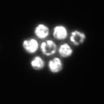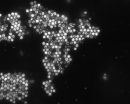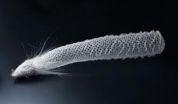(Press-News.org) Insects form swarms, fish school, birds flock together. Likewise, one species of bacteria forms dynamic, living crystals, says new research from Rockefeller University. Biophysicists have revealed that fast-swimming, sulfur-eating microbes known as Thiovulum majus can organize themselves into a two-dimensional lattice composed of rotating cells, the first known example of bacteria spontaneously forming such a pattern.
"The regular, repeated arrangement of the microbial cells shares the geometry of atoms within a mineral crystal, but the dynamics are fundamentally different; the bacterial crystals constantly move and reorganize as a result of the power generated by individual cells within them," says study author Albert Libchaber, Detlev W. Bronk Professor and head of the Laboratory of Experimental Condensed Matter Physics.
The single cells' rotating motion -- which forms the crystals by drawing in other cells and then powers the crystals' own motion -- led the researchers to dub them "microscopic tornadoes" in a paper awaiting publication in Physical Review Letters.
It's no coincidence that Thiovulum majus is among the fastest swimming bacteria known. Capable of moving up to 60 body lengths per second while rotating rapidly, these microbes propel themselves using whip-like flagella that cover their surfaces. But in its natural habitat, deep in marsh water, these microbes don't travel much. They tether themselves to a surface and use their flagella to generate a current strong enough to pull in the nutrients they need: sulfides from rotting organic matter and oxygen used to burn the sulfides.
What one cell can do, many can do much better, and in previous work, Libchaber and postdoc Alexander Petroff examined how groups of tethered Thiovulum organize and reorganize themselves so as to pull in more nutrients.
"Because this microbe can generate so much force with its flagella, we became curious about what dynamics might emerge when many swim freely together," Petroff says of the investigation, which began when study co-author Xiao-Lun Wu, of the University of Pittsburg, was visiting. "After we put an enriched culture of Thiovulum under a microscope, this beautiful structure appeared."
Researchers set about determining the balance of physical forces that explain how the microbes organize themselves into crystals. When placed in an observation chamber within a microscope slide, the microbes swam either up or down until they collided with the glass. But even then, they kept on swimming, like flies trying to escape through a closed window, Petroff says.
Swimming in place, the cells draw water toward, then up and around themselves, creating a tornado-like flow. This flow pulls in nearby cells, which cluster together in a shifting two-dimensional lattice that is similar to the three-dimensional pattern that defines crystals. Within the lattice, each cell has six immediate neighbors, creating a hexagonal pattern that appears frequently in nature, including among penguins packing together for warmth and in the chambers of honeycomb. It is the densest way to pack things of a uniform size.
But the bacterial crystal continues to reorganize and melt, animated by the cells' rotating motion, which causes the microbes to shift against one another, in much the same way that gravity pulls sand grains down the sides of a pile.
It's not clear why the microbes form these crystals, or even if they do so in habitats outside of microscope slides. But the coherent group behavior responsible for generating the crystals is a common phenomenon, known as collective dynamics.
"Usually, when birds, insects, fish, or even bacteria move together in a coordinated fashion, you see coherent motion on the scale of the group, but disorder at the level of the individual," Libchaber says. "This is not so for Thiovulum. Instead of turbulent movement, the individual cells form extremely regular crystalline structures. It appears that Thiovulum crystals represent a new form of collective dynamics."
INFORMATION:
Scientists at The University of Manchester have discovered that a previously known gene also helps cells divide normally and that its absence can cause tumours.
The glucocorticoid receptor (GR) has previously been shown to have a role in cell development, immune response and metabolism. It is found in almost every cell in the body. Many widely used drugs, including prednisolone, act through this protein.
The research from Manchester, to be published in the journal Proceedings of the National Academy of Sciences (PNAS), showed a new role for GR after the scientists ...
The stigma associated with particular neighborhoods has a direct impact on economic transactions, a team of New York University sociologists has found.
Their study, which appears in the journal Proceedings of the National Academy of Sciences, shows that when sellers are seen as being from an economically disadvantaged neighborhood, they receive fewer responses to advertisements placed in online marketplaces.
"Advertisements identifying the seller as a resident of a lower-income neighborhood received significantly fewer responses than advertisements identifying the ...
PROVIDENCE, R.I. [Brown University] -- Life may seem precarious for the sea sponge known as Venus' flower basket. Tiny, hair-like appendages made essentially of glass are all that hold the creatures to their seafloor homes. But fear not for these creatures of the deep. Those tiny lifelines, called basalia spicules, are fine-tuned for strength, according to new research led by Brown University engineers.
In a paper published in the Proceedings of the National Academy of Sciences, the researchers show that the secret to spicules' strength lies in their remarkable internal ...
ANN ARBOR, Mich. - What happens in the moments just before death is widely believed to be a slowdown of the body's systems as the heart stops beating and blood flow ends.
But a new laboratory study by the University of Michigan Medical School reveals a storm of brain activity that erupts as the heart deteriorates and plays a surprising destabilizing role in heart function.
This near-death brain signaling may be targeted to help cardiac arrest patients survive. Most of the more than 400,000 Americans who experience cardiac arrest at home, at work or in public die without ...
Researchers sketching out a wiring diagram for rat brains -- a field known as "connectomics" -- have discovered that its structure is organized like the Internet.
For years, scientists looking for clues to brain function through its structure focused on what could be seen -- the brain's lobes, grooves and folds. Now, with a more comprehensive picture of how neurons connect to one another, they've discovered local networks of neurons nested into one another like shells.
"The cerebral cortex is like a mini-Internet," said Larry Swanson, professor at the USC Dornsife College ...
Scientists funded by the National Institute of Allergy and Infectious Diseases (NIAID), part of the National Institutes of Health, have identified a cellular receptor for rhinovirus C, a cold-causing virus that is strongly associated with severe asthma attacks. A variant in the gene for this receptor previously had been linked to asthma in genetic studies, but the potential role of the receptor, called CDHR3, in asthma was unknown. The new findings help clarify the function of CDHR3 and point to a novel target for the development of prevention and treatment strategies against ...
Researchers are always searching for improved technologies, but the most efficient computer possible already exists. It can learn and adapt without needing to be programmed or updated. It has nearly limitless memory, is difficult to crash, and works at extremely fast speeds. It's not a Mac or a PC; it's the human brain. And scientists around the world want to mimic its abilities.
Both academic and industrial laboratories are working to develop computers that operate more like the human brain. Instead of operating like a conventional, digital system, these new devices ...
New mothers in the Philippines spend more time in the bedroom with their partner in the first few weeks after giving birth than they did before they became pregnant. This might be a type of survival strategy to keep the relationships with the fathers of their new babies alive and well, to ensure continued support for their offspring. So says Michelle Escasa-Dorne of the University of Colorado in the US, after studying how women from a society with a low divorce rate such as the Philippines adapt to being both mothers and lovers. The study appears in Springer's journal Human ...
WINSTON-SALEM, N.C. - April 6, 2015 - A commonly prescribed antidepressant caused up to a six-fold increase in atherosclerosis plaque in the coronary arteries of non-human primates, according to a study by researchers at Wake Forest Baptist Medical Center. Coronary artery atherosclerosis is the primary cause of heart attacks.
The study is published in the current online issue of the journal Psychosomatic Medicine.
"The medical community has known for years that depression is closely associated with heart disease, but we didn't know if treating it would reduce the heart ...
A new UCLA study takes another step toward the early understanding of a degenerative brain condition called chronic traumatic encephalopathy, or CTE, which affects athletes in contact sports who are exposed to repetitive brain injuries. Using a new imaging tool, researchers found a strikingly similar pattern of abnormal protein deposits in the brains of retired NFL players who suffered from concussions.
The innovative imaging technique uses a chemical marker combined with positron emission tomography, or PET scan, and was initially tested in five retired NFL players ...



